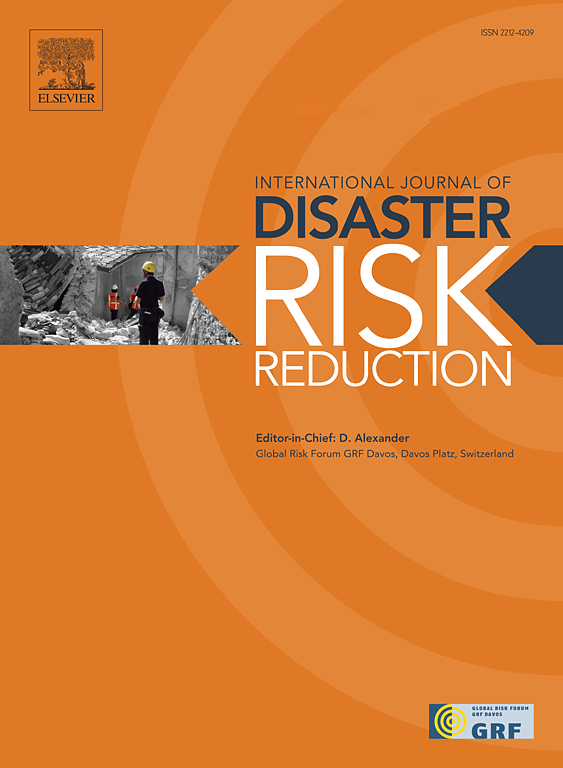Stress testing hospitals using service measures and resilience indicators
IF 4.2
1区 地球科学
Q1 GEOSCIENCES, MULTIDISCIPLINARY
International journal of disaster risk reduction
Pub Date : 2025-04-17
DOI:10.1016/j.ijdrr.2025.105492
引用次数: 0
Abstract
Within healthcare systems, hospitals provide essential acute and emergency care to save lives and mitigate the impacts of potentially disruptive events on communities. To ensure that hospitals are ready to deal with such events, their resilience must be estimated. Although frameworks to do this exist, they mostly consist of checklists for assessing hospital preparedness which leave it to the decision-makers to determine the effects of resilience-enhancing interventions on service provision and to prioritise interventions accordingly. To help bridge this gap, this paper presents a framework to assess overall hospital resilience using service measures and resilience indicators. As intended to be used to assess resilience to hypothetical scenarios of interest, it is referred to as a stress testing framework. The framework uses five service measures and twenty indicators to estimate and quantify resilience. The values of the resilience indicators and the values of the service measures are explicitly connected, and the resilience assessment is done by comparing the values of service measures at the current operational condition against the values at the baseline condition, i.e., the reference condition at which the hospital is supposed to work. The framework is explained using a fictive example based on a tertiary hospital in Beirut, Lebanon. The framework provides a clear structured high-level overview of the resilience of hospitals and facilitates decision-making as to which actions should be taken to improve resilience.
使用服务措施和弹性指标对医院进行压力测试
在卫生保健系统内,医院提供必要的急症和急诊护理,以挽救生命并减轻潜在破坏性事件对社区的影响。为确保医院做好应对此类事件的准备,必须对其复原力进行评估。虽然存在这样做的框架,但它们大多是用于评估医院准备情况的清单,这让决策者决定增强复原力的干预措施对服务提供的影响,并相应地确定干预措施的优先次序。为了帮助弥合这一差距,本文提出了一个使用服务措施和复原力指标评估医院整体复原力的框架。由于打算用于评估对感兴趣的假设场景的弹性,它被称为压力测试框架。该框架使用五项服务措施和二十个指标来估计和量化弹性。弹性指标的值与服务措施的值明确地联系在一起,弹性评估是通过将当前运行条件下的服务措施值与基线条件(即医院应该在的参考条件下工作)的值进行比较来完成的。以黎巴嫩贝鲁特一家三级医院为例,对该框架进行了解释。该框架提供了关于医院复原力的清晰结构化高级别概述,并促进了应采取哪些行动以提高复原力的决策。
本文章由计算机程序翻译,如有差异,请以英文原文为准。
求助全文
约1分钟内获得全文
求助全文
来源期刊

International journal of disaster risk reduction
GEOSCIENCES, MULTIDISCIPLINARYMETEOROLOGY-METEOROLOGY & ATMOSPHERIC SCIENCES
CiteScore
8.70
自引率
18.00%
发文量
688
审稿时长
79 days
期刊介绍:
The International Journal of Disaster Risk Reduction (IJDRR) is the journal for researchers, policymakers and practitioners across diverse disciplines: earth sciences and their implications; environmental sciences; engineering; urban studies; geography; and the social sciences. IJDRR publishes fundamental and applied research, critical reviews, policy papers and case studies with a particular focus on multi-disciplinary research that aims to reduce the impact of natural, technological, social and intentional disasters. IJDRR stimulates exchange of ideas and knowledge transfer on disaster research, mitigation, adaptation, prevention and risk reduction at all geographical scales: local, national and international.
Key topics:-
-multifaceted disaster and cascading disasters
-the development of disaster risk reduction strategies and techniques
-discussion and development of effective warning and educational systems for risk management at all levels
-disasters associated with climate change
-vulnerability analysis and vulnerability trends
-emerging risks
-resilience against disasters.
The journal particularly encourages papers that approach risk from a multi-disciplinary perspective.
 求助内容:
求助内容: 应助结果提醒方式:
应助结果提醒方式:


